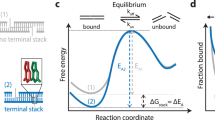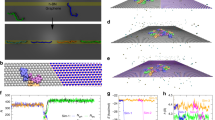Abstract
The properties of water at the nanoscale are crucial in many areas of biology, but the confinement of water molecules in sub-nanometre channels in biological systems has received relatively little attention. Advances in nanotechnology make it possible to explore the role played by water molecules in living systems, potentially leading to the development of ultrasensitive biosensors. Here we show that the adsorption of water by a self-assembled monolayer of single-stranded DNA on a silicon microcantilever can be detected by measuring how the tension in the monolayer changes as a result of hydration. Our approach relies on the microcantilever bending by an amount that depends on the tension in the monolayer. In particular, we find that the tension changes dramatically when the monolayer interacts with either complementary or single mismatched single-stranded DNA targets. Our results suggest that the tension is mainly governed by hydration forces in the channels between the DNA molecules and could lead to the development of a label-free DNA biosensor that can detect single mutations. The technique provides sensitivity in the femtomolar range that is at least two orders of magnitude better than that obtained previously with label-free nanomechanical biosensors and with label-dependent microarrays.
This is a preview of subscription content, access via your institution
Access options
Subscribe to this journal
Receive 12 print issues and online access
$259.00 per year
only $21.58 per issue
Buy this article
- Purchase on Springer Link
- Instant access to full article PDF
Prices may be subject to local taxes which are calculated during checkout





Similar content being viewed by others
References
Israelachvili, J. & Wennerstrom, H. Role of hydration and water structure in biological and colloidal interactions. Nature 379, 219–225 (1996).
Petrovykh, D. Y., et al. Nucleobase orientation and ordering in films of single-stranded DNA on gold. J. Am. Chem. Soc. 128, 2–3 (2006).
Petrovykh, D. Y., Kimura-Suda, H., Whitman, L. J. & Tarlov, M. J. Quantitative analysis and characterization of DNA immobilized on gold. J. Am. Chem. Soc. 125, 5219–5226 (2003).
Shu, W. et al. DNA molecular motor driven micromechanical cantilever arrays. J. Am. Chem. Soc. 127, 17054–17060 (2005).
Thundat, T., Wachter, E. A., Sharp, S. L. & Warmack, R. J. Detection of mercury vapor using resonating microcantilevers. Appl. Phys. Lett. 66, 1695–1697 (1995).
Lavrik, N. V., Sepaniak, M. J. & Datskos, P. G. Cantilever transducers as a platform for chemical and biological sensors. Rev. Sci. Instrum. 75, 2229–2253 (2004).
Raiteri, R., Grattarola, M., Butt, H.-J. & Skládal, P. Micromechanical cantilever-based biosensors. Sens. Actuators B 79, 115–126 (2001).
Burg, T. P. et al. Weighing of biomolecules, single cells and single nanoparticles in fluid. Nature 446, 1066–1069 (2007).
Li, M., Tang, H. X. & Roukes, M. L. Ultra-sensitive NEMS-based cantilevers for sensing, scanned probe and very high-frequency applications. Nature Nanotech. 2, 114–120 (2007).
Gupta, A., Akin, D. & Bashir, R. Single virus particle mass detection using microresonators with nanoscale thickness. Appl. Phys. Lett. 84, 1976–1978 (2004).
Ilic, B. et al. Enumeration of DNA molecules bound to a nanomechanical oscillator. Nano Lett. 5, 925–929 (2005).
McKendry, R. et al. Multiple label-free biodetection and quantitative DNA-binding assays on a nanomechanical cantilever array. Proc. Natl Acad. Sci. USA 99, 9783–9788 (2002).
Zhang, J. et al. Rapid and label-free nanomechanical detection of biomarker transcripts in human RNA. Nature Nanotech. 1, 214–220 (2006).
Wu, G. et al. Bioassay of prostate specific antigen (PSA) using microcantilevers. Nature Biotechnol. 19, 856–860 (2001).
Calleja, M., Tamayo, J., Nordstrom, M. & Boisen, A. Low noise polymeric nanomechanical biosensors. Appl. Phys. Lett. 88, 113901 (2006).
Bumbu, G. G., Wolkenhauer, M., Kircher, G., Gutmann, J. S. & Berger, R. Micromechanical cantilever technique — a tool for investigating the swelling of polymer brushes. Langmuir 23, 2203–2207 (2007).
Reddy, M. R. & Berkowitz, M. Hydration forces between parallel DNA double helices: Computer simulations. Proc. Natl Acad. Sci. USA 86, 3165–3168 (1989).
Rau, D. C., Lee, B. & Parsegian, V. A. Measurement of the repulsive force between polyelectrolyte molecules in ionic solution: Hydration forces between parallel DNA double helices. Proc. Natl Acad. Sci. USA 81, 2621–2625 (1984).
Hagan, M. F., Majumdar, A. & Chakraborty, A. K. Nanomechanical forces generated by surface grafted DNA. J. Phys. Chem. B 106, 10163–10173 (2002).
Antoniou, A. et al. Average risks of breast and ovarian cancer associated with BRCA1 or BRCA2 mutations detected in case series unselected for family history: a combined analysis of 22 studies. Am. J. Hum. Genet. 72, 1117–1130 (2003).
Mertens, J., Álvarez, M. & Tamayo, J. Real-time profile of microcantilevers for sensing applications. Appl. Phys. Lett. 87, 234102 (2005).
Tao, N. J., Lindsay, S. M. & Rupprecht, A. Structure of the DNA hydration shells studied by Raman spectroscopy. Biopolymers 28, 1019–1030 (1989).
Schneider, B. & Berman, H. M. Hydration of the DNA bases is local. Biophys. J. 69, 2661–2669 (1995).
Bryan, W. P. Thermodynamics of water–biopolymer interactions: irreversible sorption by a single uniform sorbent phase. Biopolymers 25, 1967–1979 (1986).
Casanova, F., Chiang, C. E., Li, C.-P. & Schuller, I. K. Direct observation of cooperative effects in capillary condensation: the hysteretic origin. Appl. Phys. Lett. 91, 243103 (2007).
Briones, C. et al. Ordered self-assembled monolayers of peptide nucleic acids with DNA recognition capability. Phys. Rev. Lett. 93, 208103 (2004).
Mateo-Martí, E., Briones, C., Pradier, C. M. & Martín-Gago, J. A. A DNA biosensor based on peptide nucleic acids on gold surfaces. Biosens. Bioelectron. 22, 1926–1932 (2007).
Hagan, M. F. & Chakraborty, A. K. Hybridization dynamics of surface immobilized DNA. J. Chem. Phys. 120, 4958–4968 (2004).
Peterson, A. W., Heaton, R. J. & Georgiadis, R. M. The effect of surface probe density on DNA hybridization. Nucleic Acids Res. 29, 5163–5168 (2001).
Sader, J. E. Calibration of rectangular atomic force microscope cantilever. Rev. Sci. Instrum. 70, 3967–3969 (1999).
Acknowledgements
D.R. acknowledges the fellowship funded by the Autonomous Community of Madrid (CAM). J.T., M.C., J.M. and D.R. acknowledge financial support from the Spanish Ministry of Science (MEC) under grant TEC2006-10316 and CAM under grant 200550M056. C.B. acknowledges funding provided by MEC under grant BIO2007-67523. Work at Centro de Astrobiología was supported by the European Union (EU), Instituto Nacional de Técnica Aeroespacial (INTA), MEC and CAM. All the authors acknowledge A. Cebollada, J.M. García-Martín, J. García, J.L. Costa-Kramer, M. Arroyo-Hernández and J.V. Anguita for their assistance in carrying out the gold deposition on the cantilevers.
Author information
Authors and Affiliations
Contributions
J.T., J.M. and M.C. designed the hydration experiments. J.T., J.M., D.R. and M.C. developed the measurement instrument. C.B., J.A.M.-G. and C.R. designed the PNA experiments for ruling out the effect of electrostatic forces. J.M., M.C. and C.R. carried out the experiments. All authors analysed the data. J.T., M.C., C.B. and J.A.M.-G. wrote the manuscript and all authors proofread it.
Corresponding author
Supplementary information
Rights and permissions
About this article
Cite this article
Mertens, J., Rogero, C., Calleja, M. et al. Label-free detection of DNA hybridization based on hydration-induced tension in nucleic acid films. Nature Nanotech 3, 301–307 (2008). https://doi.org/10.1038/nnano.2008.91
Received:
Accepted:
Published:
Issue Date:
DOI: https://doi.org/10.1038/nnano.2008.91
This article is cited by
-
Hydration solids
Nature (2023)
-
Piezoelectric and flexoelectric effects of DNA adsorbed films on microcantilevers
Applied Mathematics and Mechanics (2023)
-
Design and parametric study of a tapered polymer-based suspended microfluidic channel for enhanced detection of biofluids and bioparticles
Microsystem Technologies (2023)
-
Recent Advances in Peptide Nucleic Acids for Rapid Detection of Foodborne Pathogens
Food Analytical Methods (2020)
-
A Review on Surface Stress-Based Miniaturized Piezoresistive SU-8 Polymeric Cantilever Sensors
Nano-Micro Letters (2018)



